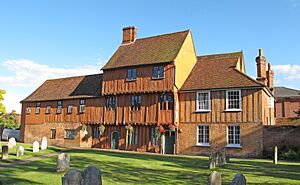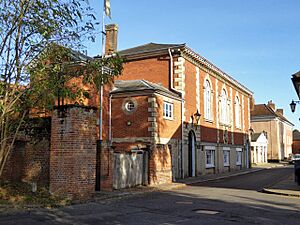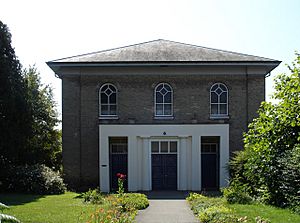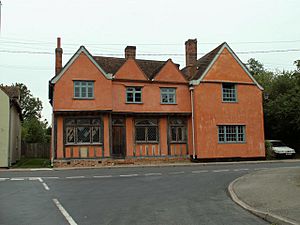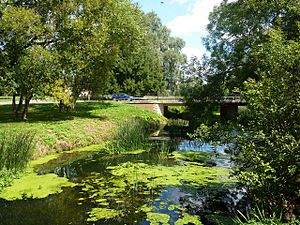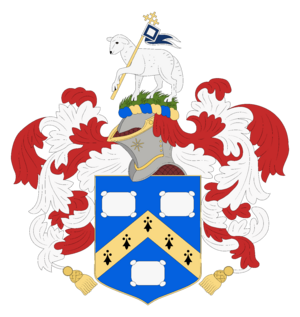Hadleigh, Suffolk facts for kids
Quick facts for kids Hadleigh |
|
|---|---|
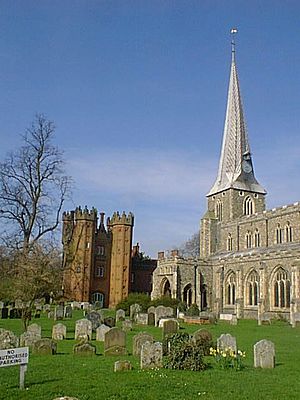 St Mary's Church and Deanery Tower |
|
| Population | 8,253 (2011) |
| OS grid reference | TM0342 |
| Civil parish |
|
| District |
|
| Shire county | |
| Region | |
| Country | England |
| Sovereign state | United Kingdom |
| Post town | IPSWICH |
| Postcode district | IP7 |
| Dialling code | 01473 |
| Police | Suffolk |
| Fire | Suffolk |
| Ambulance | East of England |
| EU Parliament | East of England |
| UK Parliament |
|
Hadleigh is an old market town and civil parish in the Babergh area of Suffolk, England. It sits by the River Brett, between the bigger towns of Sudbury and Ipswich. In 2011, about 8,253 people lived there.
Contents
What's in a Name?
The name Hadleigh comes from old words. Experts like Walter Skeat say it means 'heath-lea'. A "heath" is an open area with small shrubs, and a "lea" is a meadow or grassland. So, it likely means a "meadow on the heath".
A Look Back in Time
It's believed that Guthrum, the King of the Danes, was buried in the church grounds in Hadleigh. He was defeated by King Alfred in a big battle in 878.
The first known lord of Hadleigh was ealdorman Byrhtnoth. He was a powerful leader who died in battle in 991. Hadleigh got its special permission to hold a market in 1252. It even had a grammar school by 1275, which is very old!
The town was once controlled by the Priory Church of Canterbury Cathedral. This meant it was directly managed by the Archbishop of Canterbury.
In 1306, Hadleigh was a medium-sized town with about 1,100 to 1,200 people. Many people worked on the manor's farm, growing crops and raising animals.
Some historians think that Wat Tyler, a famous leader of the 1381 Peasants' Revolt, might have lived in Hadleigh about 20 years before the revolt. Records show a Wat Tyler taking over land in the town in 1358–59.
Hadleigh became rich because of its wool and cloth industries. You can still see many beautiful old buildings from this time. These include the 15th-century timber-framed Guildhall and other buildings with fancy plasterwork called "pargeting". Many of these are on High Street, Angel Street, Benton Street, and George Street.
The Guildhall buildings are actually three separate parts. They are the Market House, the Guilds Halls, and the New Town Hall. These buildings are on land that used to belong to Toppesfield Hall. In 1252, King Henry III of England allowed Hadleigh to have a weekly market and a yearly fair. Later, in 1438, a group called the Hadleigh Market Feoffment was set up to manage the market and its buildings.
The oldest part is the Market House, which faces the churchyard. The Guilds Halls were built later, and the New Town Hall was the last addition. The grammar school was once in a building next to the Market House.
Hadleigh became an urban district in 1894. This meant it had its own local government. In 1974, it became part of the larger Babergh district.
Hadleigh has many historic buildings. Four of them are Grade I listed, which means they are very important. These include St Mary's Church, the Deanery Tower, the Guildhall, and the Coffee Tavern.
The Georgian East House on George Street is also a very important historic building. It was once used for community events. During World War II, famous figures like the Kray twins stayed there. In 2018, it was beautifully restored into two private homes.
The Toppesfield Bridge over the River Brett is from the 14th century. It's the oldest bridge in Suffolk that still carries vehicles! It was made wider in 1812. Hadleigh also had its own Corn Exchange, built in 1813, where grain was traded.
Places of Worship
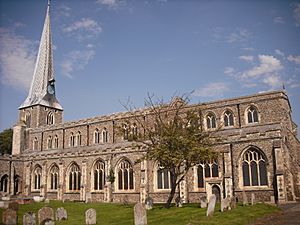
The Anglican church of St Mary the Virgin is a very old church. Its oldest parts date back to medieval times. It was made a Grade I listed building in 1950.
Some stories say that King Guthrum was buried at Hadleigh. He might have built the first Saxon church here. The church was owned by Archbishop Lanfranc of Canterbury in the time of the Domesday Book.
Next to the church is the deanery, which has a tall Tudor gatehouse. This building is also Grade I listed.
Hadleigh was known in the 16th century for its strong Protestant beliefs. Rowland Taylor, a preacher from the town, and his assistant, Richard Yeoman, were burned at the stake during the reign of Queen Mary I because of their faith.
Hadleigh has several other churches too. The United Reformed Church was first built in 1688. There is also a Baptist chapel from 1830 and St Joseph's Roman Catholic Church, built in 1966.
Local Businesses
The old Kings Arms building on Benton Street is a great example of timber framing. This building was a pub for over 400 years and has parts that are from the 15th century. It's now a private home.
Hadleigh is home to several companies. These include Jim Lawrence Handcrafted Home Furnishings and the Hadleigh Maid chocolate company.
There were plans to build a new supermarket on the Brett Works site, but these plans were not approved by the council.
Fun and Culture
The annual Hadleigh Show, also called 'the May Show', is one of the oldest one-day agricultural shows in East Anglia. It started in 1840 and attracts thousands of visitors each year.
Benton End House is a historic building that was once a large medieval farmhouse. From 1940, it was the home of Sir Cedric Morris, a famous artist and gardener. He started the East Anglian School of Painting and Drawing there. Well-known artists like Lucian Freud and Maggi Hambling studied at this school.
The Ansell Community Centre was opened in 2004. It offers many activities for the community, including a cinema called "Hollywood in Hadleigh", lunch clubs, and other events.
News and Radio
Local news and TV shows for Hadleigh come from BBC East and ITV Anglia.
You can listen to local radio stations like BBC Radio Suffolk (103.9 FM), Heart East (97.1 FM), Greatest Hits Radio Ipswich & Suffolk (106.4 FM), Nation Radio Suffolk (102.0 FM), and ICR FM (105.7 FM).
Hadleigh has its own community newspaper, Hadleigh Community News. The town is also covered by the regional newspaper, East Anglian Daily Times.
Sports and Activities
Hadleigh has a Non-League football team called Hadleigh United, who play at Millfield. The town also has the Hadleigh Rugby Club (HRFC). Both clubs have strong teams for young people and adults.
The town's bowls and cricket clubs are among the oldest in Suffolk. The bowls club started in 1754, and the cricket club is over 200 years old!
Other sports clubs include the Hadleigh Tennis Club, Hadleigh Hares running club, and Hadleigh Cycling Club.
At Benton End Farm, you can find an equestrian centre for horse riding and a paintball centre for fun games.
Hadleigh has a swimming pool, which was built in the 1960s. A sports centre was added in 2012, and the pool was rebuilt in 2020.
Famous People from Hadleigh
- Guthrum (c. 835 – c. 890), a Danish King of East Anglia, is believed to be buried in Hadleigh.
- Rowland Taylor (1510-1585), a Rector of Hadleigh, was a Protestant martyr.
- John Overall (1559-1619), who became a Bishop and helped translate parts of the Authorized King James Version of the Bible.
- Nathan Drake (1766–1836), an essayist and doctor who lived in Hadleigh.
- Thomas Woolner (1825-1892), a sculptor and poet who helped start the Pre-Raphaelite Brotherhood.
- Howard Henry Tooth (1856-1925), a neurologist who helped discover Charcot-Marie-Tooth disease.
- Cedric Morris (1889 - 1982), an artist and gardener who lived at Benton End and was famous for his special irises.
- Oswald Gayford (1893-1945), a pioneer aviator born in Hadleigh, known for his world record-breaking flights.
- Derek Wragge Morley (1920-1969), an academic known for studying ants.
- Patrick Newell (1932-1988), a British actor who played "Mother" in The Avengers, was born here.
- Pauline Stainer (1941- ), an English poet and author who lives in the town.
- Maggi Hambling (1945- ), an artist who grew up in Hadleigh.
- Ronald and Reginald Kray (The Kray Twins) were evacuated to East House during the Second World War with their mother and brother.
- The British extreme metal band Cradle of Filth was formed in Hadleigh.
- Stewart Whiting, co-founder of a medical technology company, grew up in Hadleigh.
- Geoffrey Winters (1928- ), a composer, lives nearby.
Hadleigh's Coat of Arms
Images for kids
See also
 In Spanish: Hadleigh para niños
In Spanish: Hadleigh para niños



